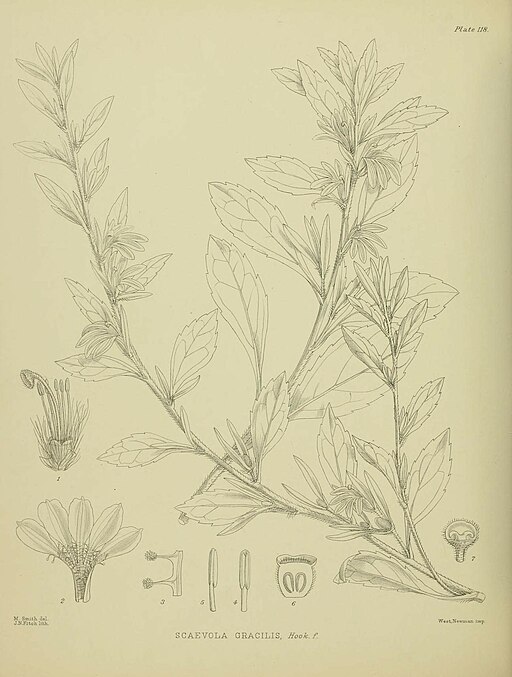Naupaka series
Naupaka is a historical fiction series that features an array of intercultural and compelling characters—from the French surgeon protagonist to Hawaiian magicians—that meet in the mind-bending context of Hawai’i’s early contact with the world. If you enjoy exotic locales, cringe-worthy explorations of early 19th-century medicine, and engaging, subtle magical realism, then you’ll love this page-turning series.
A Half Flower
On the verge of execution by guillotine, an angry, revolutionist doctor who has inexplicable visions when people die flees his fatherland and disembarks in Hawai’i to set up a base for his fellows; but when he realizes he’s an outsider in his new home, too, he must learn to forgive before another revolutionary group of magic-practicing natives who live in the mountains shackle him in their own plight for freedom.

Want free historical content?
Naupaka Flower Legend
The story of the indigenous naupaka flower is told in as many ways as there are storytellers, but all versions end the same. It is at least three hundred years old, and was passed on orally. In the most common version, Naupaka is a princess who falls in love with a commoner, and when they ask for permission to marry, they are sent to a kahuna in the mountains who is to ask the gods for permission. The gods send rain and thunder, and the kahuna brings them the sad news of refusal. Naupaka breaks a flower in half and gives one half to Kaui, who returns to the shore, and Naupaka remains in the mountains. Thenceforth, the Naupaka flower grew only in halves, one type in the mountains, another by the shore. Legend says when the lovers are reunited, the flowers will grow as whole again.

According to a chant composed in mid 1600s or early 1700s for O’ahu Chief Kuali’i, however, Naupaka was an ancestor to Kamehameha Pai’eia (the Conqueror), in direct line from Wakea (Sky Father) and Papa (Earth Mother) who created the world. In this version, Naupaka is a high-ranking man who is lured into jealousy by another man over his lower ranking, beautiful wife Ōhikimakaloa, named after a small crab residing in the Makoa sedges of the intertidal zone. Angered, Naupaka leaves, and his confused wife does everything in her power to earn back his love. She makes a lei with her own hands and places it over his shoulders, but Naupaka tears it off and throws it to the ground (very rude in Hawaiian culture), and so she leaves, broken-hearted. Where he dropped them, the torn flowers grew as shrubs with broken flowers. Ōhikimakaloa suffers and more and more resembles her namesake, the crab. Naupaka eventually realizes the mistake he made, but cannot find Ōhikimakaloa at the shore, where he then turns into the broken-flowered, now-namesake shrub. The half blossom of the naupaka flower is said to resemble his face, and a protrusion beneath the half flower symbolizes the lei niho palaoa he wore beneath his chin as a chief. Till today, the Ōhikimakaloa crab climbs the shore and seeks shelter under the naupaka bush’s embrace.
Hawai’i’s Legends, Prophecies, and Folk Stories
For historical fiction writers, the early 1800s in Hawai’i are a unique time because while the West experienced industrialization and moved into analytical thinking, Hawaiians based life on enjoyment and sacrificed to the gods. Contact between the cultures was filled with misunderstandings we can now smirk and cry over, but which posed real threat to both parties back in the day. Europeans and Americans came with metallic weaponry, virtually unknown to the islands, and showed their prowess by killing when deemed necessary. Hawaiians had a range of rules for conduct outsiders knew nothing of, and, once it was established the white-skinned longnecks weren’t immortal, could be avenged for misbehaving.
Prophecies were popular among Hawaiians, and one of the difficulties faced by Westerners, and particularly missionaries, was that some came true. When significant events which could not be known to those who foretold them occurred, it was difficult to persuade their followers there was no such thing as seeing the future. Two of these predictions came true during early contact with the world.
The first prediction is that by Kalaikuahulu, in the generation preceding Cook’s arrival, on the subversion of the kapu. Kapu, a sort of feudal system, divided kanakas, commoners, from their ruling class of chiefs, the ali’i. It also separated men and women when eating—only when eating. See the historical timeline below for more details on the kapu system. After Cook’s arrival and before the Calvinists arrived, Kuhina Nui (guardian of the kingdom and queen regent) Ka’ahumanu overthrew this system, simply said and leaving out a lot of the connected complexities, in order to eat with the young king Liholiho, Kamehameha II.
The second prediction shaped Kamehameha the Conquerer’s (Kamehameha I) career as uniter of the islands. As a new born he was placed on the Naha stone, a large slate of lava, by which was determined whether he was of Naha descent: if the baby remained silent during the test, he was, otherwise not. Kamehameha remained silent. If anyone was able to move the massive rock, it meant he had the power to unite the Hawaiian kingdoms. Kamehameha did so at fourteen. When he was a young chief, Cook arrived. Kamehameha found great interest and more strength in American and European weapons and united the kingdoms.
Prophecies coming true weren’t the only obstacles Westerners faced when trying to convince Hawaiians of the analytical way of life. Ruth Ke‘elikōlani, born 1826, died 1883, was a high chiefess who dedicated her life to preserving the language, customs, and heritage of Hawai’i’s pre-contact culture. When a volcano erupted and all looked as if its lava would obliterate a town, which had been evacuated, she traveled there and did a ceremony for Pele. What she did exactly is not known, as tales abound, but what is known is that the lava flow stopped. She also owned an enormous estate which would have become King Kalakaua’s and guaranteed the Hawaiian royal’s survival if he hadn’t angered her. So she gave it to her hanai (adopted) son. Ultimately, this led to the catastrophic Bayonet Constitution of 1887.
From night marchers who announce arrival with drumming, to be avoided at all costs, to shapeshifting dragon deities who protect Hawai’i’s water, Hawaiian folklore was filled with superstitions and folk stories. Many superstitions persist until today, and tourists who laugh when warned are astonished when they come true. For example, people are warned against carrying pork over Pali Highway because a pig god once angered Pele, and those who do encounter vehicle problems only solved once the pork is tossed. These stories are a part of the culture no Westerner managed to crush.
Hawai’i Historical Timeline
To give a short historical timeline of Hawai’i, I’ve divided it into seven phases, heavily leaning onto the research by James L. Haley.
Pre-contact Hawai’i
Before Kamehameha united the islands and continuous contact with the world was established, the Hawaiian islands were divided among chiefs who operated by the kapu system, comparable to the European feudal system, with the sole exception that land was redistributed when a chief died. The chief decided all kapus (a complex list of taboos on foods, lands, and practices forbidden to kanakas), and those who disregarded them were eligible for sacrifice to the gods. But death could also come by evil huna, so committing a crime and fleeing was no option. The kanakas, commoners, worked the land, and the ali’i took what they needed and often more.
Similar to the royal Habsburgs of Austria in Europe, the ali’i, the ruling class, preferred consanguine partners in order to keep the bloodline strong. The idea was based on mana, power, which only people of certain descent could claim, regardless of sex, and the amount of mana a person had was measured in detailed degrees by who their ancestors were. Like with the Habsburgs, the incest caused infertility, which became a problem for the Kamehameha line later on. What Cook and later visitors of Hawai’i noted was that the ruling class seemed to be a different race, being very large, while the commoners were scrawny in comparison. The idea of beauty lay in largeness, as it did in Polynesia.
There existed little rigidness as Europeans experienced: Hawaiians partnered as they pleased, lavishly enjoyed games, music, dance, and sports, feasted grandly, and kept no passion unlived. Very simply said, the only curb for happiness was the suppression by kapu.
The “Discovery” of Hawai’i
The first recorded contact with the outside world occurred when Captain Cook, in search of what lay between the Bering Strait and Alaska in a secret mission, approached and landed on the then-small shore of what is now Silver Beach (Botany Bay) in 1778. Beaches, or better, their sand, takes long to grow, and the Hawaiian islands were young. In honor of his earl patron, Cook named the archipelago the Sandwich Islands, which was later changed.
The English found what they described as a typically Polynesian culture nourished by taro, bananas, fish, pork, and dogs. The few clothes they wore were made of tapa, which was tediously made by thinning by pounding the inner bark of selected trees (often mulberry) until a coarse but flexible cloth emerged.
The Hawaiians were friendly but apprehensive upon first contact and spoke a variant of what Cook had encountered in Tahiti—communication was possible. When the Hawaiians first boarded the Resolution, they amiably helped themselves, but upon learning that this was rude, eagerly learned the white man’s code of conduct and traded with more honesty than Cook had ever encountered. Being a people who spit a lot, they asked where they could do so without offending.
Kamehameha the Conqueror
The young Kamehameha had seen the wonders of the white men’s guns, swords, and canon. By trading and other means, he amassed these weapons, superior to the traditional ones (two-sided daggers, throwing lances, and weaponry studded with shark’s teeth), and conquered the other kingdoms, killing tens of thousands of Hawaiians in the process. Particularly on Oahu he was reviled for the massacre at Nu’uanu Pali, where hundreds of men’s heads who had been killed were sacrificed to the gods. He suppressed rebellions for thirty years before he generally became known as the Unifier in 1810.
Subversion of the Kapu
Queen regent Ka’ahumanu overthrew the kapu system because, simply said, it disallowed her to sit with the young king during eating and therefore kept her uninformed about the kingdom. As Bingham later noted, she was not only a woman of astounding complexity but also possessed a genuine regard for the safety of the state. She had witnessed the arrival of Cook and saw, like others, that one could prosper without following the kapu, and prosper the white men did, more than Hawaiians had ever dreamed of before contact. Which is not to say that she didn’t adore power or wanted to take a back seat after the death of her husband, The Conqueror.
The kapu system also wasn’t all good. It kept power in the chiefs, who could, and did, kill who they saw fit, and furthermore encouraged killing enemies because one could gain mana by sacrificing them to the gods. It is impossible to say, despite the many good things about Hawaiian heritage, that the kapu system didn’t oppress the kanakas. In light of these events, some kanakas, unbeknownst of Ka’ahumanu’s success, fled to America and begged Calvinists to enlighten and free their people.
Protestanization of Hawai’i
If the overthrow of the old beliefs left a hole in people’s hearts, Protestant missionaries were eager to fill it. While imposing a stiff and outlandish morality on Hawaiians, they made possible the highest literacy rate in the world, made friends, and doctored to their abilities. The written word spread by missionaries became so associated with learning that they called it palapala (literacy), like the printing on tapa cloth, reminding of the printing press, and no longer distinguished it from pule (religion). And though they turned young Hawaiians at their schools into little Americans, this education empowered them to help preserve more of the culture than would have been otherwise possible. Nonetheless, the missionaries’ prudishness and Anglocentricism wrecked havoc on an indigenous culture that was in many ways lovely and in some savage.
One chief of Pu’uonua o Honaunau, temple and City of Refuge, and one of the most important heiaus of the Big Island, admitted to Protestant missionary’s wife Mrs. Judd that kapu was used to control the minds of the people—a shattering admission and powerful weapon in the hands of the missionaries. The first missionaries to arrive on the islands nonetheless genuinely thought they were doing a service to the Hawaiians, and in many ways did.
Americanization of Hawai’i
It was the missionaries’ (often neglected) children who had a different attitude, and the Victorian Zeitgeist didn’t do much to help Hawaiians. Before contact, sexual adventure for all sexes, including homosexuality, was not considered impure, but with Americanization it became one-sided in favor of men. Terms like “petticoat rule” gained popularity in the Hawaiians’ petitions for power, which shows the extent to which American values saturated the culture. Furthermore, white men married Hawaiian women and gained their land, while Hawaiian men were turned down by white women. Infanticide, prevalent before contact, was first proscribed by Ka’ahumanu in 1824 and reinforced by statute in 1835. Kamehameha V was considered, by the kanakas, “the last great chief of the olden type.”
Mark Twain, who visited the islands in 1866, wrote of what he witnessed:
“The traders brought labor and fancy diseases … in other words, long, deliberate, infallible destruction, and the missionaries brought the means of grace and got them ready. So the two forces are working harmoniously, and anybody who knows anything about figures can tell you exactly when the last Kanaka will be in Abraham’s bosom and his islands in the hands of the whites.”
Annexation of Hawai’i
It took another 32 years, with annexation in 1898, mainly in the name of American imperialism.
The Hawaiians, unable to defend themselves against French and British affronts, saught protection in Americans, who, at first not with annexation in mind, took even more of the Hawaiians’ power. Despite the high literacy rate of the kanakas, the 1887 Bayonet Constitution stole the natives’ right to vote. Though it is popularly believed the cheap sugar played a large role, most planters on the Hawaiian islands actually opposed annexation because it barred them from importing cheap labor.
Nonetheless, the Hawaiian constitution was overthrown, those who held power were imprisoned, a few were executed, and harsh rule followed until the public grew quiet.
Hawaiian Featherwork and Historical Fiction
Because the Hawaiian islands had no written word before contact, Hawaiian literature and histories emerged with and were heavily influenced by the missionaries. Those who were not influenced by Western concepts didn’t write because knowledge of the history was traditionally owned only by the kahunas and declared sacred and passed on orally. Furor was therefore great when Samuel Kamakau published “Ka Mo’olelo Hawai’i” a history of Hawaii, for anyone to read.
Its rich and complex history makes Hawai’i an enigmatic and little or often misunderstood culture and therefore difficult to write about for the masses. If one doesn’t do a lot of explaining in fictional stories set there one inevitably loses readers who don’t know anything about Hawaiian culture, and if one does one bores Hawaiian readers, or worse, causes anger. This makes Hawaiian historical fiction a little explored niche, market-wise, and writing Hawaiian historical fiction a path filled both with snares and lovely treasures.
Sources
https://www.homeyhawaii.com/blog/legends/legend-of-naupaka
https://www.hawaiimagazine.com/3-legends-about-hawaiis-king-kamehameha
https://de.hotels.com/go/usa/myths-and-legends-hawaii
“Captive Paradise: A History of Hawaii” by James L. Haley
“Residence of Twenty-five Years” by Hiram Bingham
Like What you’re reading? Share it!
FAQs
What is the central theme of “Naupaka” by Mirà Kanehl?
The central theme of Naupaka revolves around love, loss, and destiny. Set in the enchanting landscapes of Hawaii, the story intertwines Hawaiian mythology with historical romance, exploring the spiritual and emotional journeys of the characters as they navigate through life’s challenges and magical possibilities.
How does Hawaiian mythology influence the plot of “Naupaka”?
Hawaiian mythology plays a significant role in Naupaka. The story draws from the legend of the Naupaka flower, a symbol of separation and unfulfilled love. Mira Kanehl masterfully blends this ancient legend with the lives of her characters, creating a captivating narrative that bridges Western and Native.
Who would enjoy reading “Naupaka” by Mirà Kanehl?
Naupaka will appeal to readers who enjoy romance novels with elements of mythology and spirituality. Fans of historical fiction set against exotic backdrops, as well as those with an interest in Hawaiian culture and folklore, will find the story deeply engaging and meaningful.
Is “A Half Flower” part of a series or a standalone novel?
A Half Flower is the first novel in the Naupaka series, deeply enriched by Mira Kanehl’s extensive research into Hawaiian history and culture. Readers can immerse themselves fully in this novel without needing to read any previous works, although those interested in more of Kanehl’s books will find her other works equally compelling.
Where can I purchase the “Naupaka” series by Mirà Kanehl?
The Naupaka series by Mirà Kanehl is available for purchase through various online platforms and her official bookshop https://mira-kanehl.com/bookshop-store/.

